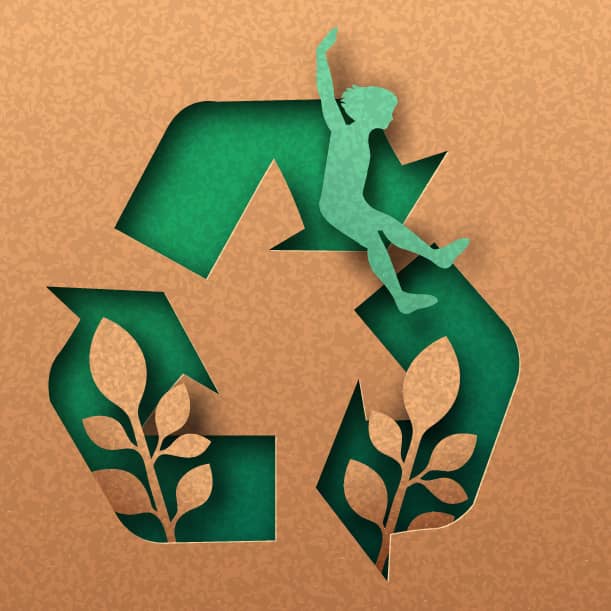3 min read
Are Consumer Attitudes About Paper Products Improving?
.png) Two Sides
:
May 1, 2023 12:00:00 AM
Two Sides
:
May 1, 2023 12:00:00 AM

*This article originally appeared on Two Sides
As U.S. consumers become increasingly aware of the environmental impacts of the
products they use every day, there remains a wide gap between perception and reality when it comes to the sustainability of paper products – but the gap has narrowed over the past two years. Overall, 44% of consumers believe paper products are bad for the environment, down from 48% in 2021, according to a new survey commissioned by Two Sides North America and conducted by global research firm Toluna.
“It’s great to see improvement in consumer attitudes about paper and the environment, but we need to accelerate this trend if paper products are to remain competitive in an ever-changing marketplace,” says Two Sides North America President Kathi Rowzie. “More and more consumers are factoring environmental impacts into their purchasing decisions, but all too often those decisions are based on longstanding myths, pop culture headlines and corporate greenwashing rather than facts,” she explains.
“Everyone whose livelihood depends on paper has a role in changing this. As the world moves toward a more sustainable, circular economy, the paper and paper-based packaging industry has a great, fact-based environmental story to tell: The life cycle of paper is already circular.”
What’s happening to the size of U.S. forest area?
Paper use is often blamed for forest loss, and 55% of those surveyed believe U.S. forests are shrinking, an improvement over 2021, when 60% of consumers said they believe U.S. forest area is decreasing. The facts: U.S. forest area grew by 18 million acres between 1990 and 2020, according to the U.N. Food and Agriculture Organization’s most recent Global Forest Resources Assessment. That’s an area equivalent to 1,200 NFL football fields every day. Contrary to the popular belief that manufacturing and using paper destroys forests, the demand for sustainably sourced paper and paper-based packaging creates a powerful financial incentive for millions of private landowners to not only manage and harvest their land responsibly, but to also keep it forested rather than converting it to non-forest use or selling it for development — the leading cause of deforestation in the United States according to the U.S. Forest Service.
What percentage of paper is recycled?
Paper recycling in the United States is a hands down environmental success story, but most consumers don’t know it. According to the survey, only 12% of consumers know the U.S. recycling rate exceeds 60%, up from 11% in 2021. Four in 10 consumers believe the paper recycling rate is less than 30%. The facts: More than two-thirds (68%) of all paper and paper-based packaging in the U.S. is recycled, and more than 91% of corrugated cardboard is recycled, according to the American Forest and Paper Association. The U.S. Environmental Protection Agency (EPA) reports that paper is the most recycled material in the country, compared to plastics at 9%, glass at 25% and metals at 34%.
Is electronic communication more environmentally friendly than paper-based communication?
As companies continue to resort to unsubstantiated “go green, go paperless” marketing claims to help them cut costs, 68% of consumers surveyed believe that electronic communication is more environmentally friendly than print on paper, up from 67% in 2021. Clearly, consumers want to do the right things when it comes to the environment, but are often misled by corporate greenwashing that fails to acknowledge the environmental impacts of digital communication.
The facts: The EPA reports that the pulp and paper industry accounts for only 0.6% of total U.S. greenhouse gas (GHG) emissions – which isn’t surprising since 64% of the energy needs at U.S. pulp and paper mills are met using renewable, carbon neutral biofuels, mostly biomass. In contrast, the rapidly expanding information communication technology (ICT) industry has a growing carbon footprint arising from GHGs released during all stages of the electronics life cycle. A recent meta-analysis (Freitag, Berners-Lee, et al, 2022) estimates the ICT industry is responsible for up to 3.9% of global GHG emissions and that those emissions will continue to increase without both regulatory and industrial intervention. Unlike the recycling success story of paper products, only 15% of the approximately 7 million metric tons of e-waste generated in the United States each year gets recycled, according to the 2020 Global E-waste Monitor. The rest is landfilled, burned or dumped, causing harm to both the environment and human health.
“The life cycle of paper products is circular by nature,” Rowzie explains. “The raw material used to make them is perpetually regrown, the energy used to manufacture them is generated using mostly renewable, carbon-neutral biofuel, and the circle is completed as used paper is recycled into new products at a higher rate than any other material. Even so, our survey shows that misconceptions about the sustainability of paper products are commonplace. It’s just these types of misconceptions that Two Sides is working to correct. We believe consumers have the right to make purchasing choices based on data and hard facts, free from pop mythology and greenwashing.”
The 2023 Two Sides Trend Tracker Survey queried 1,000 respondents over age 18 across the United States. It is the second of Two Sides’ biennial trend tracker studies designed to explore and better understand consumer perceptions, behaviors and preferences related to the sustainability of paper products.





